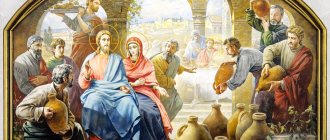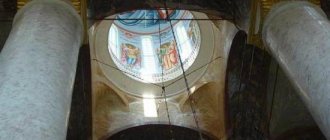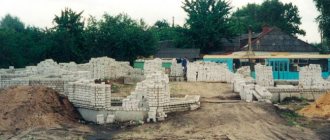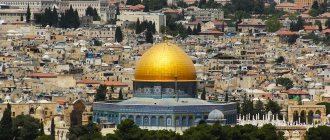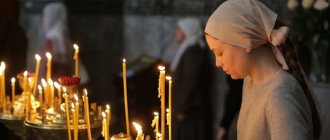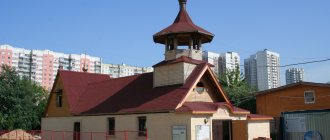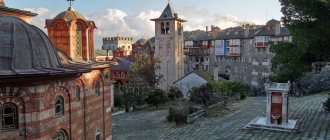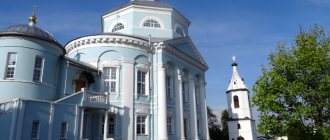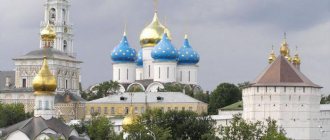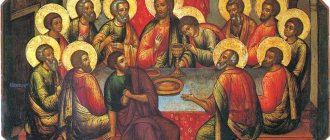The Temple of the Apostle Canaanite is one of the main shrines of Abkhazia, which attracts hundreds of tourists and pilgrims every year. The ancient building is a true example of the architectural art of those times; the design of the temple was greatly influenced by the style of the great Byzantine Empire. The church itself is small in size, made of ash-white stone.
In recent years, the temple has been closed for restoration. It can only be viewed from the outside.
Now the temple opens only once a year - on May 23, the day of the Apostle Simon the Canaanite. On this day, a religious procession takes place; thousands of pilgrims flock to New Athos to pay tribute to the memory of the man who introduced the country to Orthodoxy and died for a just cause. Pilgrims take part in the festive liturgy and also pray to the saint for the well-being of their family. The closed doors of the temple are not a problem for believers - they pray leaning against the walls. There is a candle in one of the walls of the temple. In the backyard there is a spring flowing directly from the wall of the temple.
© Julia Alisova
The structure consists of traditional crosses and domes. Previously, all the walls of the shrine were decorated with unique frescoes, but time has not been kind to the painting, and contemporaries cannot enjoy its beauty. But the inscriptions in Greek located above the entrance gate to the temple and above the facade of the building can still be read.
Panoramic view of the Temple of Simon the Canaanite in Abkhazia
About the Apostle Simon the Canaanite
Before your trip, be sure to read the life of Simon the Canaanite or read this article to the end, I will try to tell you the most important things. Otherwise, the apostle is called Simon the Zealot - this name appears in the Gospel of Luke. Simon is one of the sons of Joseph, which means he is the half-brother of Jesus Christ.
Researchers associate the nickname Canaanite with Cana of Galilee, when Jesus turns water into wine at the wedding of Simon, who, from what he saw, believed in the Lord and followed Jesus. Church ministers call the apostle the patron saint of marriage and family. Simon preached in Judea, Syria, Libya, Egypt, Armenia and Abkhazia - folk traditions testify to this.
So Simon the Canaanite, together with Andrew the First-Called, arrived on the land of Iveron (Abkhazia, New Athos) to preach Christianity. Abkhazian parables tell about a certain Simon, who healed with prayer and splashes of river water. Simon chose a cave in the gorge of the stormy mountain river Psyrtskha as a place of solitude. It was possible to enter the cell only through the hole at the top; this required a rope. Local residents who believed in the teachings of Christ came to the apostle to pray and brought Simon food and some clothes. How long the apostle stayed in Anakopia is unknown, but according to the legends of local residents, it was only thanks to the sermons of the Canaanite that the Abkhazians took the righteous path and abandoned paganism in the name of Christ. After all, at that time the ritual of child sacrifice and cannibalism was popular among the Abkhazians.
But Simon had haters - the pagan king of Georgia Aderki was against the Christianization of neighboring peoples, so he ordered the death of the apostle. It is still not known for certain how Kananite was tortured, but there are two versions based on the traditions of the ancient Abkhazians. According to one of them, Simon was beheaded with a sword, according to the other, he was sawn apart with a saw. There is even a legend about how the apostle was crucified on the cross.
Simon was buried not far from a cave in New Athos; now there is an artificial waterfall nearby, and on the relics of the saint in the 9th century, the temple of Simon the Canaanite was built from limestone slabs. Despite numerous persecutions (Arab and Turkish expansion), the Abkhaz retained their faith in Christ and revere Saint Simon the Canaanite, who preached Christianity despite persecution. The Simono-Kananitsky Temple was destroyed several times, and now no services are held in it. But on the side, hidden from the eyes of tourists, believers leave icons and notes with requests, and light candles.
Christians honor the memory of the Apostle Simon the Zealot (Cananite) on May 23.
Is it possible to get inside?
Unfortunately, the temple is currently closed for restoration. Given the church schism in Abkhazia that has existed since 2011, it nevertheless belongs specifically to the Abkhazian Orthodox Church, and not to the schismatics who took control of the New Athos Monastery. Let's hope that all the confusion and proceedings will subside, but for now you can go around this wonderful temple, and behind, in the outer niche in its wall in the area of the altar, put a candle with a request to the great Saint Simon for his prayerful help for your family.
Grotto cell of Simon the Canaanite - how to get there?
The first time we arrived in New Athos, we did not have time to visit the Kananita cave, but this time we decided to definitely go.
The entrance to the gorge territory is at Psyrtskha station. To get there you need to go from the city center following the sign towards the waterfall. Near the waterfall you will see the three-apse cross-domed temple of Simon the Canaanite. You need to climb the steps along the waterfall and exit to the station. Now go along the railway, on the left you will see the entrance to the gorge territory. A ticket to enter will cost 150 rubles (with a purchased ticket you can later enter for free). The path to the apostle’s cave was refined at the beginning of the 19th century by New Athos monks who arrived from Old Athos (Greece) and built the huge New Athos monastery in Anakopia. But you still need to be careful, and I don’t recommend that older people go into the cave alone, as they will have to climb about 200 stone and slippery steps. The climb is quite difficult, it runs along the river, at the very top there is a railing that will protect you during the climb.
Now there is no need to climb into the cave through the hole at the top; the monks cut an entrance to the apostle’s cell and again laid a staircase. Near the entrance to the cave you can buy candles. In the Canaanite grotto itself, you will see portraits of Jesus and Simon, laid out in mosaics - the authors are the monks of the New Athos Monastery, the works date back to the 19th century.
On the way to Kananite's cell, you will see a large stone with a dent on it that clearly resembles a human footprint. It is believed that this trace was left by Simon the Canaanite.
And on the other side of the river you will notice a stone cross; if you look closely, you can see stones with red splashes in the water; according to legend, the apostle was killed at this place, and the stones preserved the blood of the saint. The Psyrtskha River is considered life-giving, you can drink the water from it and you can swim here (the temperature is always about 5 degrees). For the convenience of pilgrims, there are booths along the shore where you can change clothes.
Walk a little behind the cave, a huge clearing with majestic fir trees will open in front of you; in this place you want to sit for hours and enjoy the peace.
But in 2015, trouble happened: someone dared to desecrate the apostle’s cell, sneaked into the cave under the guise of a tourist, collected all the icons in the cell and burned it. But now there are again many icons in the cell, probably more than fifty!
Current state[edit]
There are six churches in total in the monastery: the gate temple - the Ascension of the Lord, the temple of the Holy Apostle Andrew the First-Called, the temple in honor of the venerable fathers of Athonite, the temple in the name of the martyr Hieron (heavenly patron of the rector Archimandrite Hieron (Vasiliev)) and the temple in honor of the icon of the Mother of God "Deliverer".
In the center of the quadrangle formed by the buildings of the monastery, Panteleimon Cathedral, built in 1888-1900, rises. It is crowned with five domes; the height of the central one is 40 meters. The length of the cathedral is 53.3 m, width - 33.7 m. The cathedral was built in the neo-Byzantine style, common in Russian church architecture of the late 19th - early 20th centuries. The inside walls were painted in 1911-1914 by masters from the village of Palekh, Vladimir province, and a group of Moscow artists led by M. V. Molov and A. V. Serebryakov. Panteleimon Cathedral is the largest religious building in Abkhazia.
Under the bell tower there is a former monastery refectory, the walls of which, like in small churches, are painted with frescoes made by famous Volga masters - the Olovyannikov brothers.
Temple of Simon the Canaanite
It is a monument of the 8th century, made in the Byzantine style. Previously, it was the main Abkhaz Christian church before its destruction by Muslims. Currently, only the shape and a few wall paintings on the facade remain of the majestic temple. In the 14th century, the church was decorated with frescoes; Simon the Canaanite, St. Andrew the First-Called and the Dormition of the Mother of God were depicted on the walls. For several centuries the temple was destroyed during Muslim expansion. And after 1875, Alexander III issued a decree transferring the church into the possession of the New Athos Monastery, then the monks began to restore the damaged areas of the building, and the shape of the temple changed slightly.
Currently, the church annually holds a liturgy with a procession of the cross on May 23, the day of remembrance of the Apostle Canaanite. On other days you cannot enter the church, as it is under restoration.
Description[edit]
The Church of Simon the Canaanite is a three-apse cross-domed temple. The original porches are now lost. Previously, the walls were plastered on the inside and painted with frescoes (not preserved). The church is decorated with images of Christian symbols such as fish, lion and cross, made in the form of reliefs.
Pilgrim and antiquities researcher A.P. Muravyov, who visited the church in the first half of the 19th century, left the following description:
Historical tradition points to this church as the burial place of St. Apostle, located in a fairly vast clearing, washed by the waves of the Psyrtskhi River. The wild, picturesque place seems to have been deliberately created by nature to lure people to live. In the middle of the clearing there is a small church, but almost completely intact, except for the collapsed dome; its western porch is littered with stones and overgrown with wild plants, like the very top of the church, the entrance is from the southern porch, above which the half-erased face of the Savior is visible. The structure of the temple is Greek, with a triple division of the altar, and a semicircle of the high place. The thinness of the walls and the height of the slender vaults, which rest on extremely light pillars, are amazing; the painting has already been erased, but on the western wall the Assumption of the Mother of God and two martyrs are still visible.
Another traveler, who was in the temple at about the same time, described it this way:
The church has the shape of a quadrangle; on the western side there is a special aisle with a strong surviving vault, on the right side of the aisle there is a passage into the dungeon, covered with earth and rubble. The southern, northern and western doors are covered with porticoes with stone vaults; the walls are made of white-grayish strong wild stone, cleanly hewn, with patterned ancient cornices; the masonry is of remarkable strength; although the dome and roof have long since collapsed, the walls are still strong; Inside, the plaster shows the remains of ancient fresco painting: the image of some saint, a young maiden crowned with a royal crown, the image of some martyr similar to St. George, above the western doors, the image of the Dormition of the Blessed Virgin Mary has been preserved quite clearly; in the chapel on the right side, an image of three saints, less preserved; their vestments are made of brocade decorated with crosses, and St. Basil the Great - chess of white and black squares. The western wall and the altar were overgrown with laurel and fig trees, picturesquely stretching along the inner walls to the ground. It is wonderful that these trees bear fruit every year.
Dream Interpretation of Simon Kananita
On the Internet you can find the dream book of Simon the Canaanite online; this seemed strange to me, given that very little is known about the apostle; official sources do not say anything about the fact that Simon was involved in the interpretation of dreams (he certainly had no time for that). The creators of such a resource say that the ancient Greek literary monument “Book of Dreams,” which was found in the Caucasus (where exactly is not specified), served as the basis for the creation of Kananite’s dream book. And in the 18th century, the book was translated into Russian and presented to Catherine II (there is also no official information about this).
But in fact, it is not clear what relation Simon the Canaanite has to this book, and in general I could not find anything about this ancient literary monument. So you don’t even have to go to sites offering to read the dream book of Simon the Canaanite. But you definitely need to come to New Athos and visit the memorial sites of the Apostle!
Booking.com
Excursions to New Athos
Usually excursions are carried out as part of trips to New Athos, where the monastery is located. This is a living tradition of Christianity. It is expressed in the fact that a large book was placed in a separate part of the temple for tourists. The icons and paintings were never restored at all. You can look at the temple from the time of its creation and design. However, everything is in a state of constant renewal. Monks do something, often wear construction clothes, confirming that faith without works is dead.
The excursion can go towards Lake Ritsa. It fascinates with its icy calm. The essence of the beauty of Abkhazia cannot be comprehended in one place. You need to see these mountain lakes, calm rivers for mountainous areas. So you will understand why the apostle arrived in that Abkhazia, which was not even called that then. There is a special energy there that makes itself clearly known.
